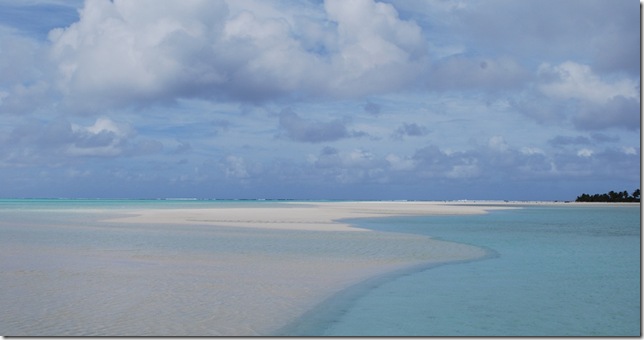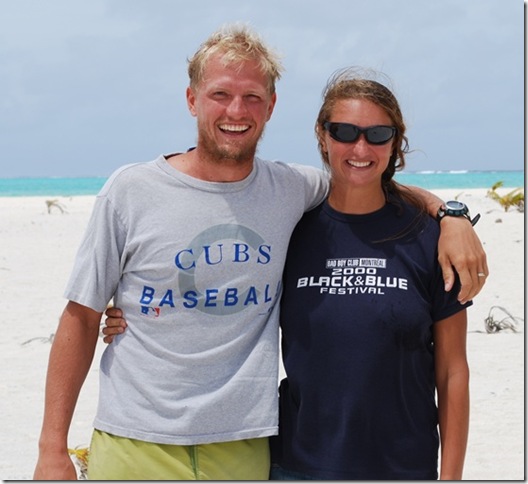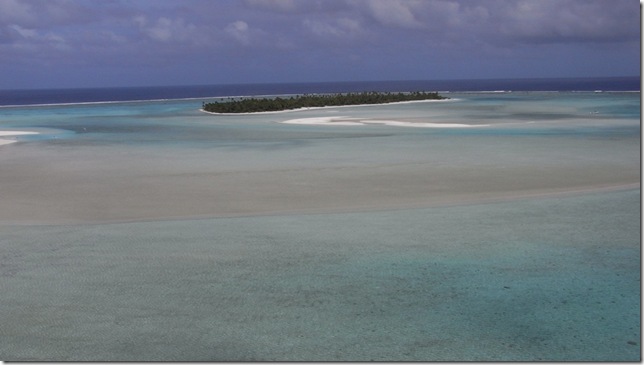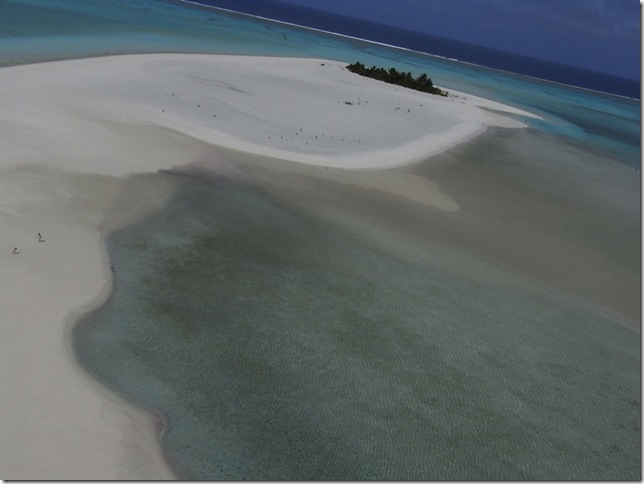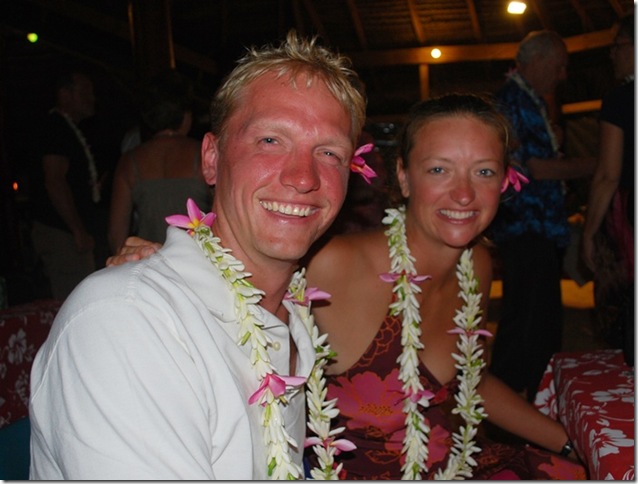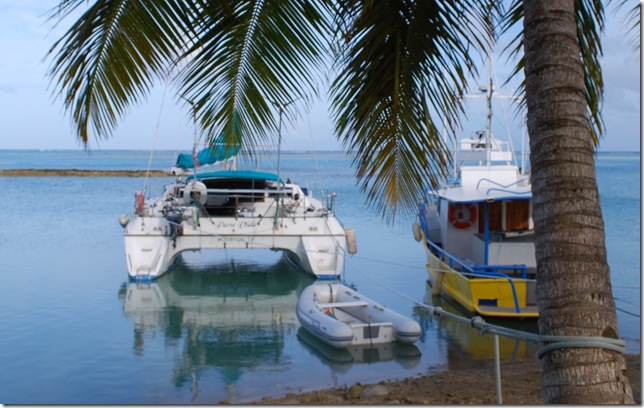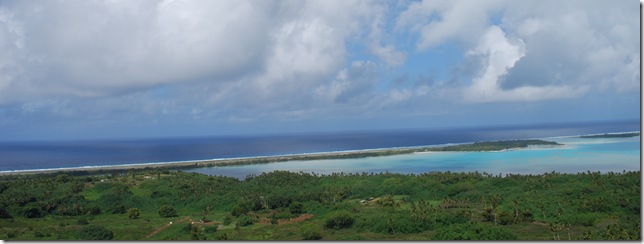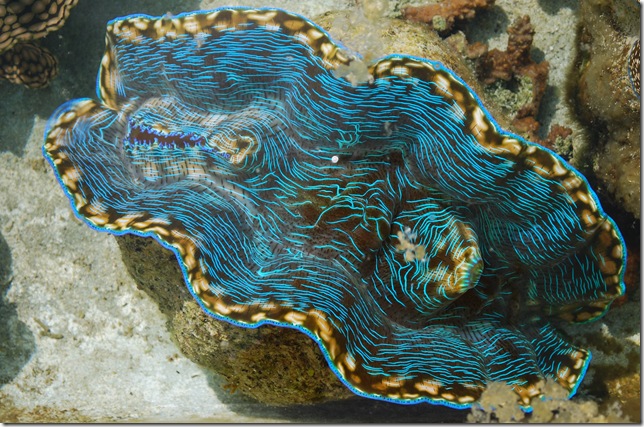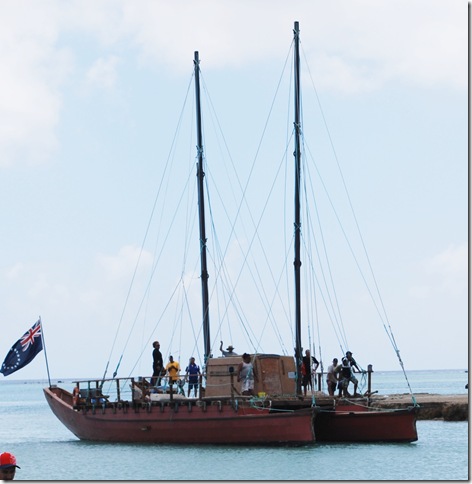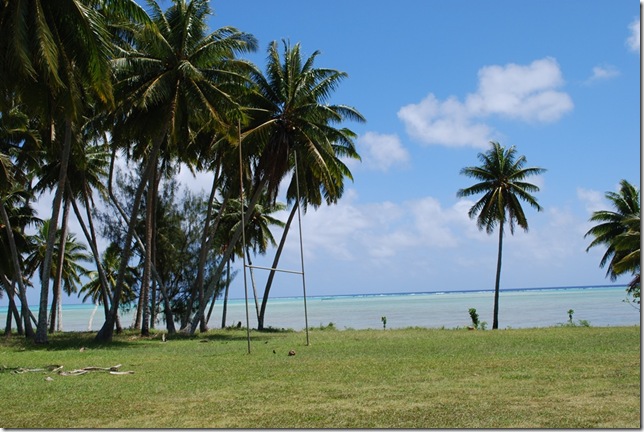We’re finally leaving Aitutaki today after a very enjoyable stay. We completed preparations yesterday. There’s a large rain water cistern not too far from the boat, so I lugged 84 gallons of water 12 gallons at a time while Lauren transferred the water into the tanks. We haven’t filled the tanks for a couple of weeks and have done a fair amount of laundry in that time, so we’re still doing OK on water usage. We’ve been doing laundry by hand since we left the Galapagos and are getting used to it, but we’re looking forward to the possibility of a reasonably priced laundromat in New Zealand.
This is the first place we’ve been where it’s technically prohibited to bring trash ashore, but we did it anyway, as most of it was stuff from Aitutaki, and all the other cruisers were using the trash barrels in the port area.
When we checked out, we found out that departure tax is $55 NZ per person, so the total cost for all of the formalities has come out to $345 NZ (about $240 US), which is more than we’d anticipated, but without the large amount of French funding present in French Polynesia, it is understandable. In general, the people seem to be about as well off here as they are in French Polynesia, even without the subsidies. One of the noticeable differences is that people drive a lot of scooters instead of the new 4×4 trucks that were everywhere in French Polynesia. We’ve also noticed a lot more gardening or farming on both a small and medium scale.
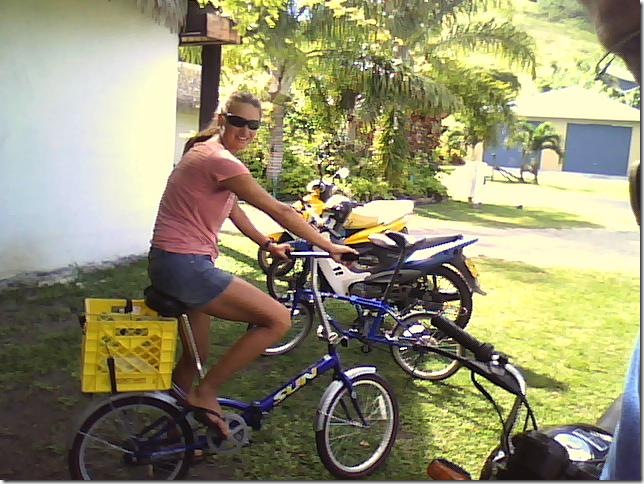 Our “nice push-bikes” as the locals call them alongside the local conveyance
Our “nice push-bikes” as the locals call them alongside the local conveyance
I also had a chance to get my ear checked out again, this time by a very busy Chinese doctor in the local hospital at the top of the hill. He confirmed that I do have some hearing loss in the left ear but said that the inflammation was gone and it looked perfectly healthy. He suspected a blockage somewhere that should take care of itself eventually. Total cost — $0, free. That was nice. He was also the one person we’ve met on the island who didn’t have a thick Kiwi accent. Cook Islands Maori is clearly the first language of the natives, but they also speak English with a thick Kiwi accent. It’s still a bit strange, but we’ll be getting used to it. As they enjoy New Zealand citizenship, there are at least as many Cook Islanders in New Zealand as there are in the Cook Islands themselves.
The outboard propeller is still a problem. The rubber bushing that’s designed to break if you hit something is broken on the propeller we left with, and the old prop that was on the boat makes a bad slipping sound in anything that’s much above idle, so we’re left with idle speed only for a while. Hopefully that will get us by until we can remedy the situation in Tonga or New Zealand. The boat repair list is gradually getting longer as the days go by. Yesterday I was telling Silvio from Matajusi that on our 20 year old boat, something breaks every other day though most of the time it’s not serious. He just laughed. He has a virtually new boat and said that something breaks twice a day. Repairs and keeping the boat running really are a big part of the challenge of long-distance cruising. We both agreed that with the expense and difficulty of making repairs out here, instead of performance, the sailing philosophy of cruising is centered around not breaking or wearing anything out.
The upcoming passage looks like it’s not going to be our favorite. The first half is going to have very light winds (less than 10 knots), so we’ll be inching along or motoring. One of the boats that left yesterday was visible for so long that they couldn’t have been doing more than 2 knots. We should get some more wind on the second half of the passage, but the seas will be big again. We’re well into the South Pacific Convergence Zone (SPCZ), which is an area in the western Pacific where the typical tradewinds weather gives way to less predictable weather that can include light winds as well as strong winds from atypical directions. Light winds are better than strong winds from the west, so we’re actually not unlucky.
We’ve decided to skip Palmerston and head for Beveridge Reef. Palmerston is an interesting story, so we’ll try to tell it briefly in a blog during the passage, but Beveridge Reef is less of a detour and promises some incredible snorkeling and diving. It’s just a reef in the middle of the ocean — no land or people. It’s in an oval shape and has a pass with good anchoring inside, and we’ve heard the coral is amazing. The conditions should be good when we get there, so we’re hoping for a memorable stop.
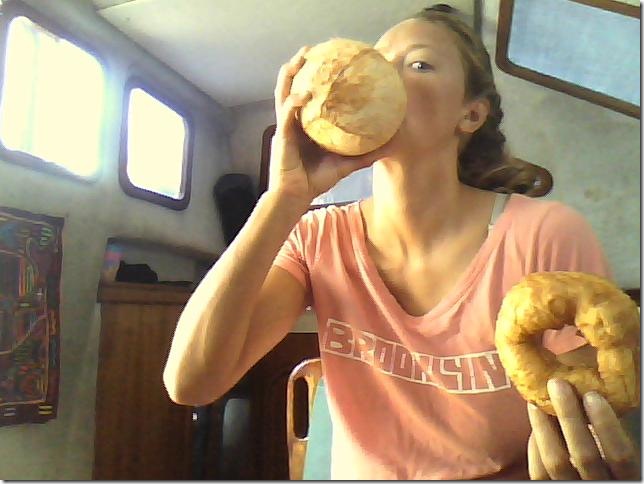 Last breakfast in Aitutaki: Local no-icing donut and coconut water
Last breakfast in Aitutaki: Local no-icing donut and coconut water
After getting some boat items taken care of on Monday (filling propane tanks, making new hatch pieces with Martin from S/V Anima, replacing some rusted bolts on the engine instrument panel, etc.), we ended the day with another mostly Beatles song session on Anima that lasted until past midnight. Martin is an incredible guitar player (a.k.a. The Human Jukebox), and Wolfgang, who joined him as crew in Bora Bora, never tires of singing. Lauren not only loves to sing, but has a great voice, and Martin was really pleased to be able to play a second night with her joining in. He has a book with music and words for the complete Beatles library, and it turns out we all knew a lot of Beatles songs.
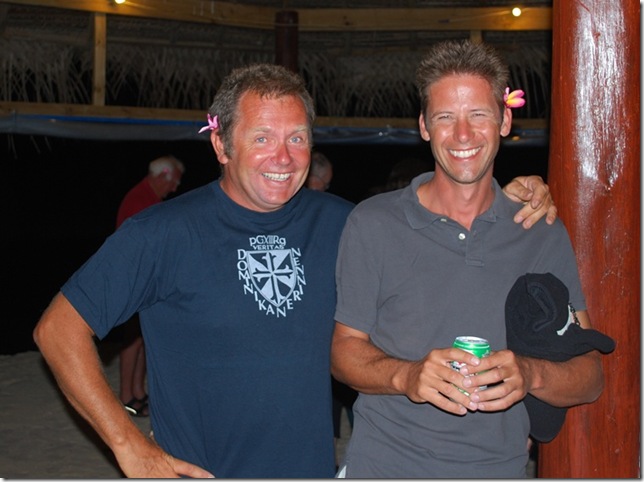 Martin (The Human Jukebox, sailor, welder, woodworker, etc.) and Wolfgang from S/V Anima III
Martin (The Human Jukebox, sailor, welder, woodworker, etc.) and Wolfgang from S/V Anima III
Tuesday was be-a-tourist day. The Aitutaki Adventures (the yellow boat for those of you headed this way) lagoon tour had received rave reviews from the other yachties, so Martin, Wolfgang, Lauren, and I gave it a shot today. It was another expectation-exceeding experience. After motoring out through a channel that was built by the Survivor TV show when they filmed here (we seem to be following these guys around the Pacific) we came to a deep part of the lagoon where we drifted for a few minutes to try to spot sea turtles, and did see a couple, although they were a fair distance from the boat. Next it was off to a beautiful motu for some snorkeling. There was the typical collection of tropical fish, but we also saw some eels, a couple of new tropical fish, and giant clams, which seem to be a unique feature here. The largest clam was at least 3 feet across, but it moved to close just like a normal-sized clam when you got too close to it. The food on the excursion was pretty impressive. After a snack of delicious fresh fruits (papaya, guava, banana, and passion fruit), we had lunch at One Foot Island. Lunch was really not what we were expecting. It was like a potluck dinner – beets, cole slaw, potato salad, two types of green salad, sweet potatoes, a papaya dish, rice, tuna, sausage, and at least a couple of other things I’m forgetting. The variety was a big change from what we’re used to, and everything was really, really good. The motus themselves were the most beautiful we’ve seen, with lots of soft white sand giving way to crystal clear water at the shore and then different shades of turquoise and blue in the deeper parts of the lagoon. Some of the motus also had areas of black volcanic rock that made a beautiful contrast with the white sand and clear water.
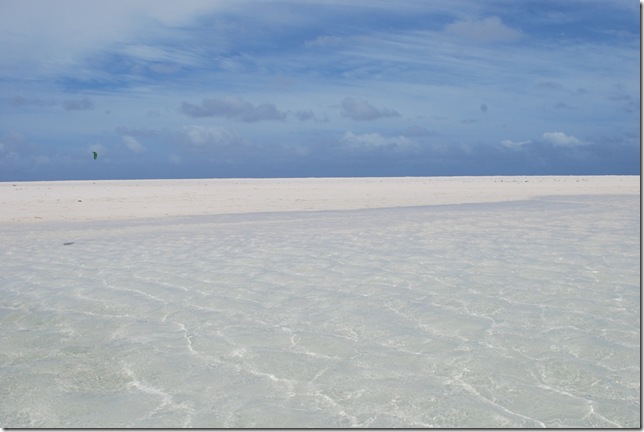 Clear water at Honeymoon Island
Clear water at Honeymoon Island
While we were snorkeling, Martin was busy taking aerial pictures of Honeymoon Island with a kite camera that he got as a gift before leaving Austria. Thanks to Martin for these pics. His website, www.anima3.net, has an English section he’s proud of.
After a short time to rest, we were off to the Samadi hotel/restaurant at the northeast tip of the island for a dinner buffet and local traditional dance show. Depending on your perspective, I was either in need of or several weeks overdue for a shave, and this seemed like a good occasion. Apparently it had been a while, because Wolfgang thought I looked like a different person and one of the locals talked with me for a couple of minutes before realizing we’d met a couple of days ago. In addition to Martin and Wolfgang, seven Brazilians from the three Brazilian boats here joined us, so we had nearly a full table of “yachties” as we’re called here. The spread of food was even bigger and more impressive than lunch and again everything was great.
After dinner the entertainment started. They started by asking for anyone who was on a honeymoon, birthday, anniversary, etc. and since Lauren and I are in the fifth month of our honeymoon and there weren’t too many people standing up, we volunteered along with a couple of the Brazilians who’d had birthdays in the last couple of days. Things started off well enough with us each getting a beautiful lei of fresh flowers, but they warned us that we would be called upon later in the evening. The Maori king of New Zealand recently made his first visit to the Cook Islands, and a traditional Maori performance group came with him, so in addition to the local show, we were also treated to a performance by the Maori group. Aitutaki is well-known across the Pacific for the quality of their dancing, and we enjoyed seeing it first-hand. The women dance with a lot of arm-swaying and hip-shaking, which is similar to dances we’ve seen before, but much of the time the men do a unique dance. It’s a bit hard to describe, but it generally involves making hand and arm gestures while their legs look like they’re doing the chicken polka at a fevered pace. The feet stay in place, but they squat a bit and move their knees back and forth very rapidly. They also do a haka dance similar to what we saw in Ua Pou but a bit less aggressive. The music behind them included percussion from a variety of drums and wooden percussion instruments that were also played at a fast pace during most of the dances. During the slower dances, a guitar, ukulele and vocals would join in.
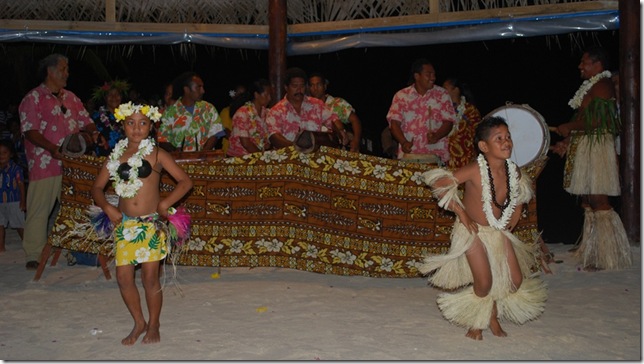 Aitutaki kids got things started
Aitutaki kids got things started
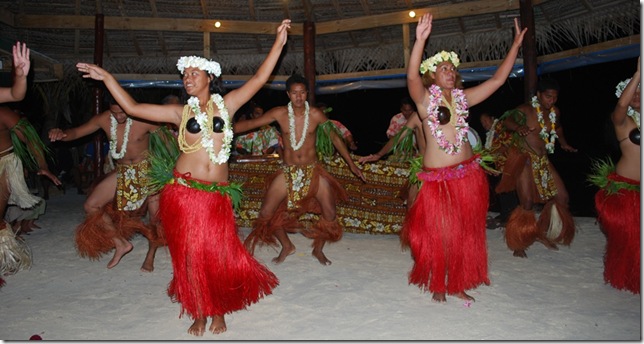 The Aitutaki dancers in action
The Aitutaki dancers in action
The Maori group was almost 20 people and they sang as if they were all hand-picked for their singing ability. Their dances weren’t quite as traditional and they seemed a bit more like a first-world trained performance group, but they were impressive. They featured plenty of the expression that was historically recorded where the eyes are made large and rolled so that there’s a lot of white showing while the tongue is stuck out almost down to the chin and accompanied by yells and fierce gestures. It was meant to intimidate back in the day and it’s certainly attention-getting.
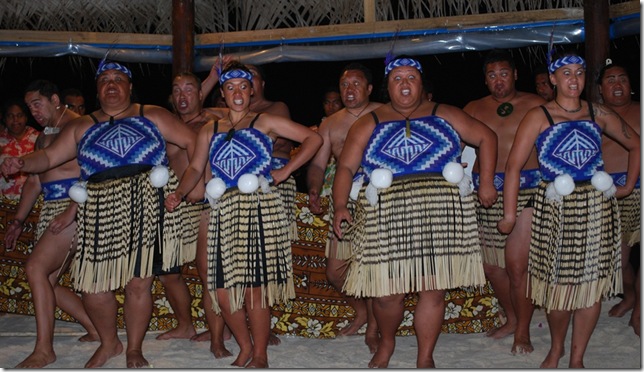 Expressive singing and chanting by the Maori group
Expressive singing and chanting by the Maori group
After the show, all the people with leis got to put on a dance show for the guests by dancing two at a time with a couple of the Aitutaki dancers, which provided plenty of laughs from everyone. The sight of us trying to do the local dances was guaranteed amusement for everybody involved.
The night was finished off by another song session on Anima that somehow lasted until 4 am, when even Martin and Wolfgang had to throw in the towel.
Needless to say, today started a bit slowly, but if the weather looks good, we’re hoping to wrap things up here and set out for Beveridge Reef and Niue tomorrow.
Aitutaki has continued to exceed expectations, especially now that we have moved from the shallow spot in which we were anchored (and rubbing against the sandy bottom) to a sort-of quay on shore. Space became available on Saturday morning after S/V Dreamtime left. (Incidentally, they are 2 years into their projected 10-year circumnavigation and summed it up by saying, "Life definitely doesn’t suck.") We put out an anchor from the bow and had some help from Bruce on S/V Migration (from California) in getting our stern lines tied up to the coconut trees on shore. In doing so, Bruce cut his foot, but Tiff was able to put her nursing skills to use in getting him bandaged up.
Tied up to a coconut tree
After settling in, Dallas and I headed out on the bikes to further explore the island. First we stopped briefly at a hotel (Tamanu Beach) that has wireless internet for a reasonable price. Then it was time to hike up another mountain. At 500 feet or so, it was more like a hill. Unlike Bora Bora, Aitutaki is very nearly an atoll, as its volcanic peak has almost receded into the ocean, leaving only the large lagoon and surrounding coral reef behind. Anyway, the peak still provided an opportunity for photos of the brilliant aesthetic that we have grown accustomed to but certainly don’t take for granted. We had planned to have a picnic on the peak, but the combination of mosquitoes and heat was pretty unbearable, so we opted to eat while we walked back down.
The lagoon encapsulated by the reef
Next we rode up to the north end of the island and stopped at the Aitutaki Marine Research Center. There we found several small pools of clams of various sizes as well as a three-legged sea turtle, a few blue starfish (very cool), and a couple of my favorite fish that have camouflage on top and black and white stripes on the bottom. Apparently the research project involves preserving the population of clams and coral in the lagoon, but the researchers were in the middle of lunch, so we didn’t get the details.
One of the giant (1’ or so) clams
We tried to find a couple of art galleries on the north end of the island, but one was closed and the other no longer there. In the process of trying to find the latter, we stopped to ask a woman in her doorway for directions. Evidently they don’t get much tourist traffic on that side of the island, and as soon as she found out that we had arrived by boat, she offered us a bunch of papaya and bananas from her fruit trees that Dallas then learned how to knock down with a long stick. She and her daughter couldn’t have been any nicer, and they encouraged us to return for more fruit if we have a chance.
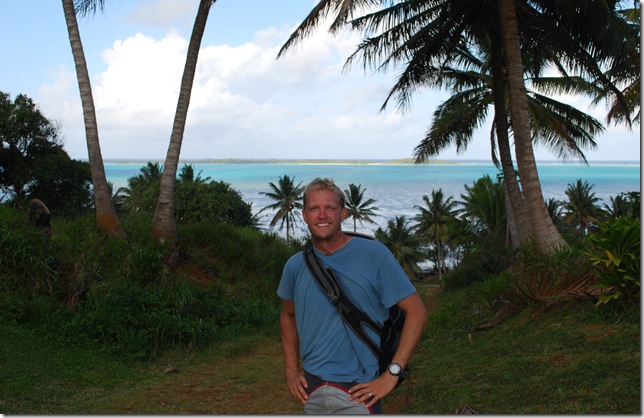 Dallas enjoying the beautiful day
Dallas enjoying the beautiful day
We ended our bicycle tour with a long ride around to the south end of the island to see the marae. It took a bit of luck to find it, as it is tucked away behind the waste management building without any signage. There is definitely less emphasis on ancient rituals and customs here than there was in French Polynesia.
We were pretty tired on Saturday night, but I always seem to have the energy to dance when there’s some good or even decent music playing. There is a restaurant/bar right here by the dock called the Blue Nun, and on Friday and Saturdays a DJ spins local and international records, so I stopped in to check it out. It was a pretty typical affair for the current MTV demographic (a "meat market", as we would say in the states), but they interspersed the American dance tunes with more traditional Polynesian ones.
Sunday morning we had a chance to experience one of the most prominent aspects of the current culture here in the Cooks by attending a local church. Dallas liked the look of one on the east side of the island that he had spotted during our bike ride, so we had a nice long walk over there during which we saw a number of locals travelling every which way to their respective churches. For as small as the island is, there are quite a lot of churches of various denominations, from Seventh-Day Adventist (we were going to attend their service on Saturday but had to move the boat) to Latter Day Saints to Jehovah’s Witness. We attended a Cook Islands Christian Church, and it was a good choice. After the initial prayer and greeting, the congregation broke out into song, and their acapella vocals were astounding. The older members seemed to be singing at the top of their lungs, and their clear, almost piercing tones reverberated off the vaulted ceiling. They sang in harmony (typically two-part) with beautiful intonation, and the song-leader seemed to switch according to the song. The Maori language is very similar to Tahitian in terms of there being a high vowel to consonant ratio, and their songs provided lots of opportunity for them to show off their pipes as they held out the vowel sounds. With the exception of the vocals that could rival the Vienna Boys Choir in terms of their quality, the service itself was pretty consistent with what I am used to in the states. The seating arrangement was a little unusual, though. Instead of sitting with their families, the younger women sat in the front showing off their pretty pandanus hats, and the men (those few in attendance) and older folks sat behind. The children sat on the sides, with the young girls chatting and teasing each other throughout. We could tell that the minister was quite an orator despite that most of the service was in the local Maori language. He took the time to greet the few of us tourists in English. He thanked us for making the effort to be there and said, "Convey our love to your friends and family back home, and tell them that Aitutaki is a good place for holidays." So there you go. 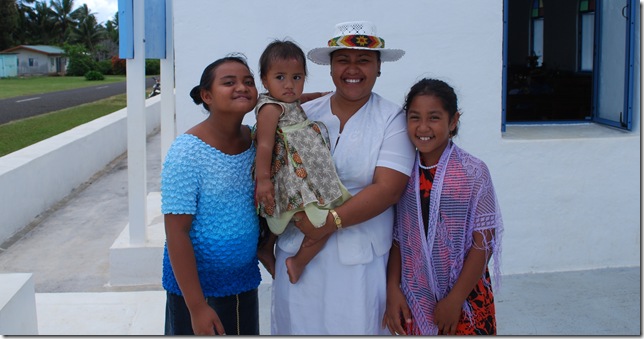
Showing off their Sunday best
On Sunday afternoon we watched a large, traditional wooden catamaran approach the dock. The Pacific Games are happening right now in Rarotonga, but the Hobie cat sailing competition is to be held here on Wednesday, so the catamaran is here to mark the occasion. We jumped aboard to check out their huge tiller up close. They have to hand steer all the time (3 hours on, 6 hours off), which we were told can be quite challenging and require more than one helmsman in bad weather.
Back on the boat, Dallas answered a radio call from our friends aboard Matajusi who arrived that morning. They are anchored outside the reef due to their deep draft and were curious about whether or not a shellfish that they found out there was edible. Dallas was eager to accommodate and found some local boys near the dock who agreed to go with us to their boat to see the shellfish and answer their questions. This was also a good opportunity for us to check out the dinghy’s outboard engine on which Dallas had just replaced the propeller in an effort to take care of the thrust problem. It turned out that the boys were quite knowledgeable about the local fish but got seasick rocking back and forth on the monohull out there, so it was a short stop, but before we left we saw a mother and baby humpback whale sounding in the distance. The outboard worked well on the way back until we were entering the pass into the lagoon, and even though the current wasn’t all that strong, it almost kept us from making our way back in and made a nasty sound when Dallas revved it. I guess the thrust problem is taken care of, but there is now a new, hopefully-related problem. Maybe the new prop just needs more grease…
Last night (Sunday) we went over to S/V Migration for a potluck that consisted of our homemade burritos plus Bruce’s jalapenos and salsa from Mexico (I couldn’t believe he still had them!) and his homemade pizza. It was quite a feast and quite good company as well. The Austrian guys from S/V Anima were really funny, and one of them led us in a sing-along of classics such as the Beatles of which everyone knew at least some of the words. He taught Dallas a number of songs and invited him over to check out his large collection of sheet music today. What’s more, he is currently helping Dallas to fix our broken escape hatch using his stainless steel welder! As I told him, he is a good guy to know.
Dallas just came back and informed me that I missed out on meeting the prime minister of the Cook Islands and the president of French Polynesia (as well as getting some free food) just now! Apparently they are here for a ground-breaking ceremony for a new museum to honor a man who had been declared dead after being lost at sea for 5 months, finally landing here on the reef weighing only 60 lbs! Talk about having will to survive. Anyway, as you may have gathered, there’s never a dull moment here in Aitutaki. I better wrap up and get back out there before I miss something else…
Ahhh. Every time we write about how beautiful someplace is, we go and move to someplace at least as incredible and we’re all out of fresh adjectives. The passage to Aitutaki, Cook Islands went reasonably well. Waiting for the weather paid off, and the wind consistently worked its way from near the beam to dead astern, with the seas eventually following and the motion improving. It did continue to blow pretty good, and we made great time with just the full jib up all the way. Aitutaki was in view when the sun came up Friday morning, just as we’d hoped.
Approaching Aitutaki from the north
We did have a couple of small adventures along the way. We have a pretty dry boat, and with all the downwind sailing of late, it’s been really dry. But after leaving Mopelia we had a large wave from the port beam that crested at just the right time to send the equivalent of several buckets of water flying over the deck and into the cockpit. We even had a gallon or so fly straight through the salon door onto the starboard settee. The area of the salon floor near there seemed to be staying wet for a long time, and the next day Tiff pulled up the rug, did a little investigating, and found that our escape hatch had broken and was letting water into the salon as waves smashed up against the bottom of the bridgedeck. The hatch is mandated by international safety regulations and is designed to allow you to leave the boat easier in the event of a capsize. We also joke that it’s our equivalent of the glass in the floor featured in the ultra-riche, over-the-water bungalows in Bora Bora. Unfortunately, the latch on one handle had broken and the piece that the handle latches to was missing on the other side. A 2.5 sq ft hole in the boat makes things a little wet when there’s a good swell running, so something had to be done. Even if we’d stopped the boat, we didn’t have all the replacement parts, and it needs to dry out to be repaired properly anyway, so after several futile attempts, I finally came up with a method of keeping it shut by tying lines from the handles to a point on the boat above it and then using screwdrivers to twist the lines tight. That was good for the last 200 miles or so. I think we have a spare latch on board, and we should be able to work something out for the other side while we’re here.
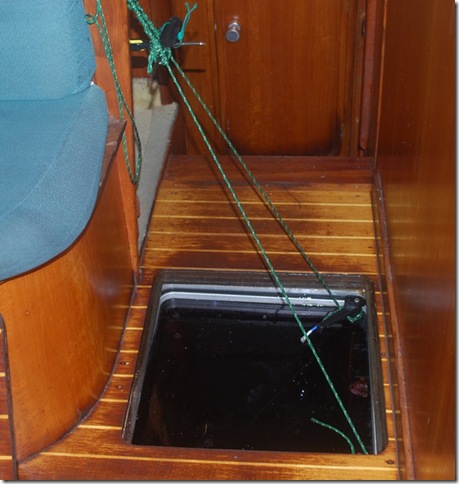 A little line, a couple screwdrivers,…
A little line, a couple screwdrivers,…
The pass and anchorage in Aitutaki makes the pass in Mopelia seem trivial. The pass here is just as narrow, but man-made, longer, and much shallower. We took our time getting in and anchoring in a tight spot with less than a foot of water under the port keel. We thought we understood from the boat beside us that the tide was low, but it wasn’t, and the port keel is now bumping occasionally. Luckily the bottom underneath it is sandy, and the rudder is in enough water, so we’re fine. Tomorrow there’s a boat leaving the sort of quay nearby, and we’ll move in to tie stern-to with an anchor out and lines run to palm trees.
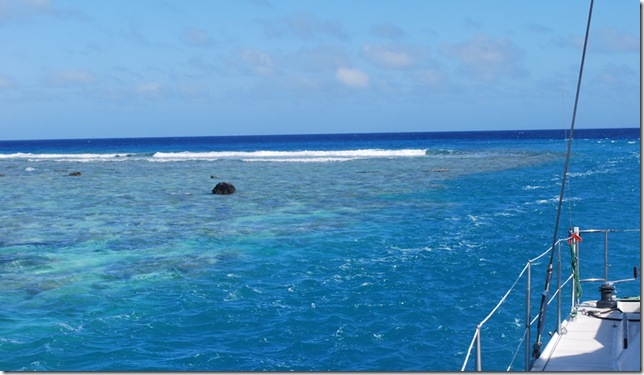 You can see how close we are to the edge of the pass as well as the churned-up water
You can see how close we are to the edge of the pass as well as the churned-up water
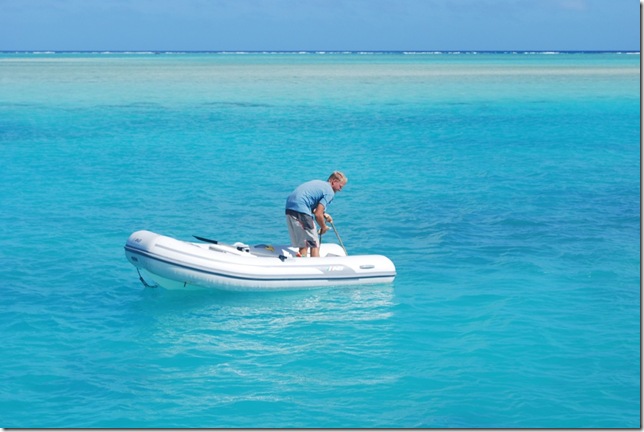 Setting a stern anchor amid a palette of blues
Setting a stern anchor amid a palette of blues
The island itself is an almost-atoll, which means it’s mostly an atoll (motus & lagoon) but also has a low (max height maybe 250 ft) main island that is inside the lagoon. Evidently the lagoon here is world-renowned for it’s beauty and landed Aitutaki on one of those US “places you must see before you die” lists. The Cook Islands are now an independent nation in free association with New Zealand, which basically means that New Zealand subsidizes the government budget and is ultimately responsible for Cook Islands foreign affairs and defense. We were a bit surprised to see several boats filled with Kiwi tourists heading out for lagoon excursions not too long after we’d set the anchor.
We got an earful of how great this place is from S/V Dreamtime on our way in, and by the end of the day we agreed. For starters, they speak English. We’d been in French Polynesia so long that we’d really become accustomed to getting around with a limited vocabulary and ability to understand things. It’s so much easier to get around and get things done when you’re fluent in one of the local languages. Dreamtime warned us that the customs guy was not in today and the agricultural inspector would seize all of our fresh fruits and vegetables, so we radioed back to the boat to give Wes and Tiff a heads-up so they could eat or hide them. The policy appears to be partly due to the association with New Zealand, which is also very strict, and partly due to their wanting to keep the islands as they are, relatively free of pests and plant diseases. That’s fair enough.
The woman at the harbor master’s office couldn’t reach anyone on the phone for us to check in with, but both the health and agricultural inspector found us at the same time while we were checking out the town. The health inspector had the form with the same questions that are asked at every port (has anyone died? any cases of cholera or plague? etc.) Cruise ships do occasionally have bodies on board, but for a small yacht they’re always funny questions. He got a laugh out of how quickly I was able to answer no all of them. The agricultural inspector had his kid with him and was in a bit of a hurry. At first, he insisted he’d have to come on board since we may have some tomatoes and a pamplemousse. When I told him Wes and Tiff were eating the pamplemousse for lunch, he eventually gave me a nudge and said “None” in reference to the form. Good enough for me. It was $20 NZ for each inspector and before I let the agricultural inspector go, I said “One more thing.” “Yes?” he asked. “How do you say hello in the local language?” We both just started laughing and laughing. All this business about tomatoes and he hadn’t bothered to say hello. “Kia Orana” is the answer, which sounds almost identical to the “Io orana” used in the Society Islands.
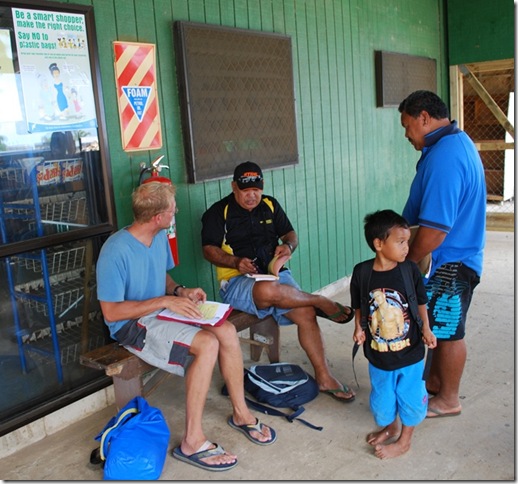 The health and agricultural officers caught up with us at the gas station
The health and agricultural officers caught up with us at the gas station
We spent some time walking around the island, finding an internet connection, and enjoying the beautiful island and weather as well as the friendly people. It’s not a rich place, but they seem to do a reasonable tourist business, things are generally well-kept, and the people seem good-natured. We were able to change the bond money we got back in Polynesian francs into New Zealand dollars, which was interesting, as the teller didn’t seem to comfortable with the calculator and exchange rates. Luckily the manager was there and everything worked out fine. The walk back to the boat was shortened by a cool guy who saw us walking and gave us a lift in the back of his truck. Almost everyone here is either on a scooter or riding in the back of a pick-up (the guy that picked us up had a 2×6 bolted in as a seat in the back of his pick-up).
For now, we’re just feeling lucky to be anchored in another beautiful lagoon enjoying the sunset by an island with friendly English-speakers and all the necessities (possibly including propane as well).


